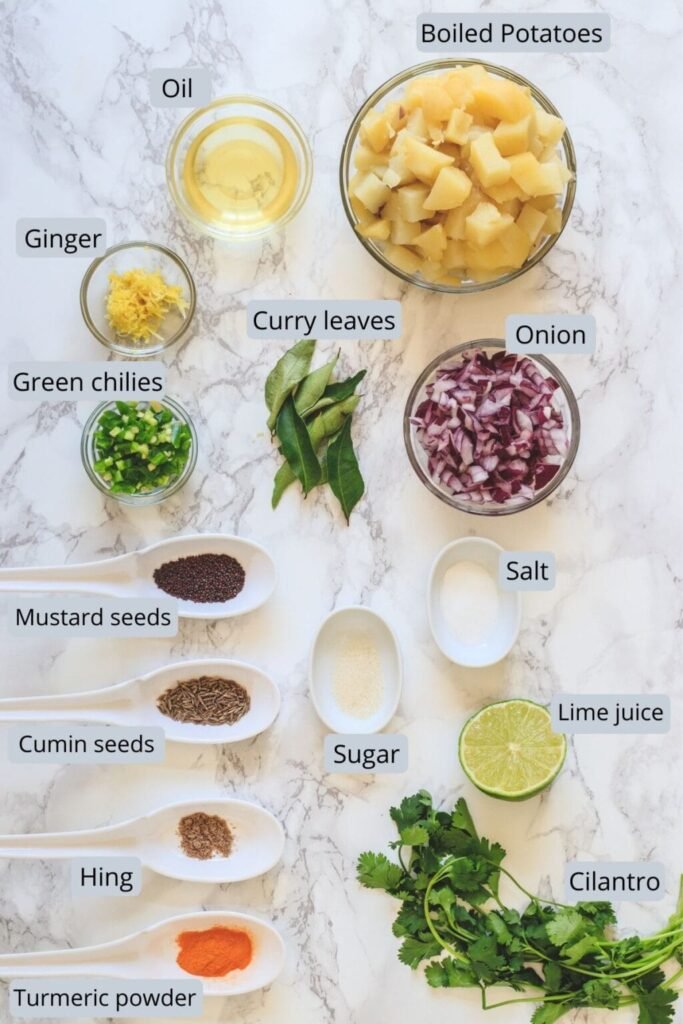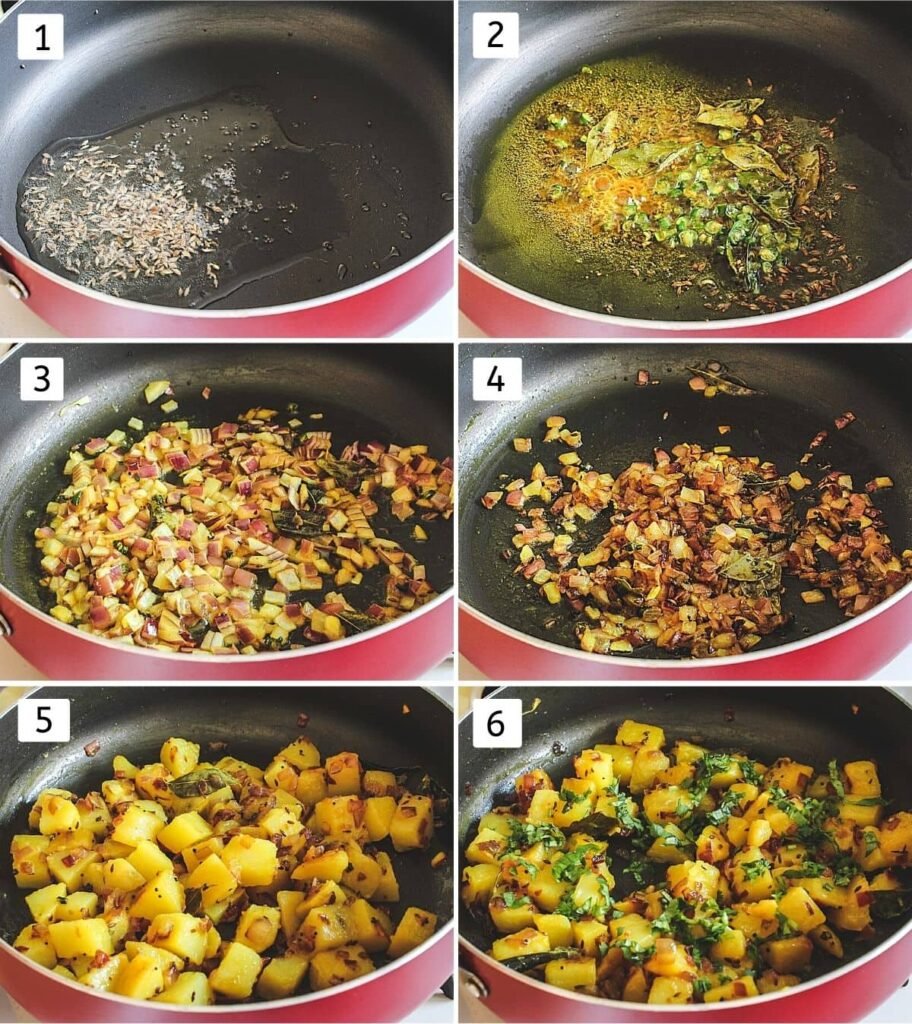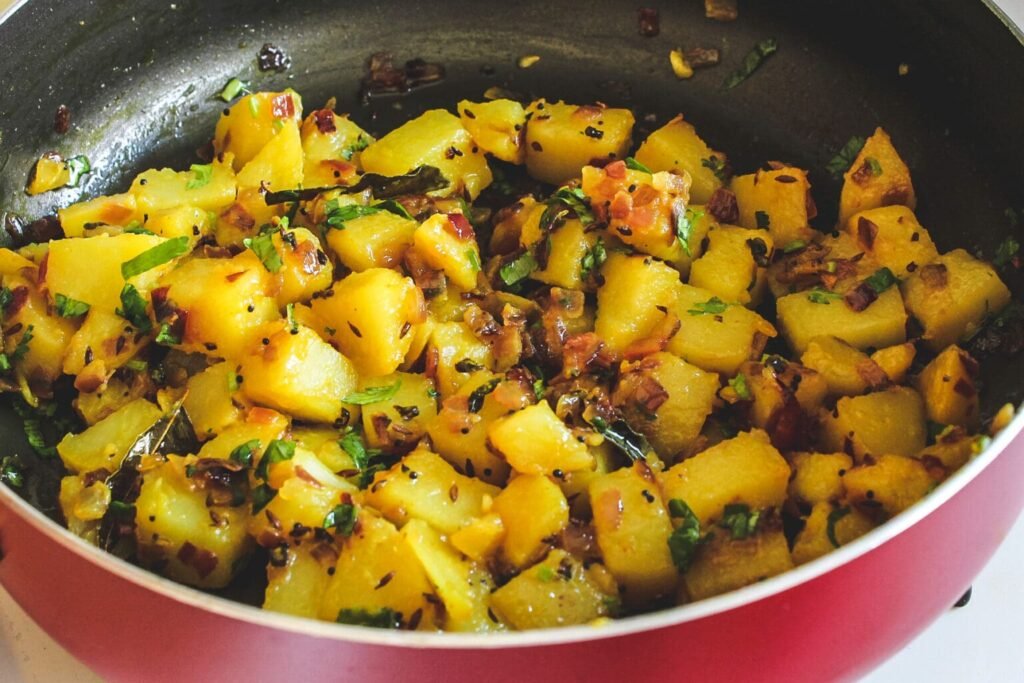Batata Bhaji is a classic Maharashtrian dish that holds a special place in everyday meals as well as festive thalis. The word “batata” translates to potato (aloo in Hindi), and “bhaji” refers to a dry vegetable stir-fry or sabzi. Batata Bhaji literally translates to a dry potato stir-fry, and while the name sounds simple, the flavors are far from plain or ordinary.

This humble yet satisfying dish is prepared using boiled potatoes that are gently stir-fried in a tempering of mustard seeds, cumin seeds, curry leaves, and hing (asafoetida), followed by sautéed onions and green chilies. A pinch of turmeric adds a beautiful golden hue and earthy flavor. It’s seasoned with salt and finished with a generous handful of freshly chopped coriander leaves for a burst of freshness.
What makes Maharashtrian Batata Bhaji truly special is its perfect balance of spice and aroma — mildly spiced, vibrant, and not greasy at all. It doesn’t rely on heavy masalas or tomatoes, which makes it light on the stomach and ideal for breakfast, lunch, or even travel tiffins. It’s also commonly served as part of the famous poori-bhaji combo, especially during festivals and special occasions.
This dish is incredibly easy to make, uses minimal ingredients, and comes together in under 20 minutes, making it a go-to option for busy weekdays. Pair it with hot puris, chapati, or even a bowl of varan-bhaat (plain dal-rice) for a truly comforting Maharashtrian meal. Each bite of this batata bhaji brings the cozy comfort of home-cooked food, gentle spices, and the familiar charm of a beloved Maharashtrian classic.
You’ll Love This Batata Bhaji Recipe
This quick and easy Maharashtrian-style batata bhaji takes only around 10 minutes to prepare, especially if you already have boiled potatoes ready. Made with basic kitchen staples, it’s a no-fuss recipe that still delivers satisfying flavor. Even though it uses just a few spices, the dish stands out thanks to the earthy fragrance of curry leaves, the light sweetness of sautéed onions, and the warm notes of turmeric. It’s a great example of how humble ingredients can come together to make something truly comforting and delicious.
One of the best parts about this batata bhaji is its versatility. Pair it with soft phulkas or ghee-laced parathas for a hearty and homely lunch or dinner. It’s also a staple in traditional Maharashtrian festive meals—especially when served alongside puris, creamy shrikhand, and other celebratory accompaniments.
Beyond traditional pairings, this dry sabzi also adapts well to fusion meals. Tuck it into a sandwich with chutney for a quick snack, use it as a filling in wraps or kathi rolls, or enjoy it as a side with dosa or plain thepla. Its soft texture and comforting flavor make it easy to incorporate into different meals, whether you’re packing a lunchbox or planning a special weekend brunch.
Simple, quick, and always comforting—this batata bhaji is a humble reminder of how regional recipes can deliver soul-satisfying flavors with minimal effort. Whether you’re making it for a busy weekday or including it in a festive thali, this dish is sure to become a reliable favorite in your kitchen.
Ingredient Notes For Potato Bhaji:

- Potatoes: Boil potatoes using a stovetop or an electric pressure cooker like the Instant Pot—both work well for this recipe. Once the boiled potatoes cool down enough to handle, gently peel off the skin and dice them into small, bite-sized cubes.
- To boil using a stovetop pressure cooker: Place the potatoes inside, and pour enough water to fully immerse them. Alternatively, place a small rack or trivet inside the cooker with about ½ to 1 inch of water, and rest the potatoes on top to steam. Cook over medium heat for 2 to 3 whistles. The time may vary based on the size and variety of the potatoes.
- For Instant Pot users: Set the timer to manual pressure for about 6 to 8 minutes. Refer to a detailed post on Instant Pot boiled potatoes for exact instructions.
- Red Onion: This ingredient is optional. If you’re preparing the batata bhaji as part of a religious offering—such as for Ganesh Chaturthi—it’s customary to avoid onions. Otherwise, sautéed onions add a nice sweetness and extra flavor to the dish.
- Green Chilies: These are the main source of heat in this simple sabzi. I usually use Indian green chilies, but serrano peppers can be a good alternative. Adjust the spice level to your preference. For a milder flavor, discard the seeds and inner white ribs before chopping the chilies.
- Curry Leaves: Don’t skip these! They bring a signature South Indian fragrance and earthy flavor to the bhaji.
- Ginger: Freshly grated ginger brings a gentle heat and aromatic depth to the dish. Use a microplane zester for best results, or substitute with ginger paste if needed.
- Turmeric Powder: This vibrant spice brings a gentle warmth and earthy flavor, while giving batata bhaji its signature golden-yellow hue and an inviting visual appeal.
How To Make Batata Bhaji?
1) Heat the oil in a heavy-bottomed pan over medium heat. When the oil is sufficiently heated, add the mustard seeds and let them begin to crackle. Allow them to crackle and pop—this enhances their nutty aroma and flavor. Next, add the cumin seeds and let them sizzle for a few seconds until fragrant, releasing their earthy essence.
2) Add the aromatics—green chilies, grated ginger, and fresh curry leaves. Sauté these for around 30–40 seconds. The green chilies will infuse the oil with heat, while the curry leaves and ginger release their distinct fragrance. Then, add a pinch of hing (asafoetida) and turmeric powder. Stir quickly to prevent the spices from burning.
3) Toss in the finely chopped onions and sprinkle a pinch of salt. Adding salt at this stage helps the onions cook faster by drawing out their moisture. Cook the onions gently until they soften and become translucent, stirring now and then to avoid any browning.
4) Keep sautéing until the onions turn tender and their raw aroma fades away. This step brings a touch of sweetness and body to the dish, balancing the spiciness of the chilies and the pungency of the ginger.
5) Now add the boiled and cubed potatoes to the pan, followed by a little more salt and a pinch of sugar to balance the flavors. Gently stir everything so the potatoes get evenly coated with the tempered spices and sautéed onions. Be careful not to mash them while mixing. Let the sabzi cook undisturbed for 2–3 minutes on low heat, giving the flavors time to come together and seep into the potatoes for a deliciously well-rounded taste. Slightly mash a few potatoes if you like a creamier texture.
6) Finish by adding freshly squeezed lime juice and a generous handful of chopped cilantro. Mix well and take it off the heat. Serve hot with puri, roti, or as part of a festive thali for a simple yet satisfying meal.

Expert Tips for Making Perfect Batata Bhaji
1. Prep Potatoes Ahead of Time
For quicker cooking, boil the potatoes in advance—either in a stovetop pressure cooker or Instant Pot. Once boiled, allow them to cool completely before peeling and chopping. This helps avoid mushiness and ensures cleaner, uniform cubes.
2. Customize the Heat
Vary the green chili amount to match your preferred spice level. For a milder version, slit the chilies or remove the seeds and inner ribs before chopping. For extra heat, leave the seeds in or add an additional chili.
3. Always Use Fresh Curry Leaves
Fresh curry leaves are key to that signature Maharashtrian aroma. When added to hot oil, they instantly release their natural aromas, forming a fragrant base that elevates the depth and flavor of the entire dish. If fresh leaves aren’t available, you may use dried ones, but fresh is highly recommended for an authentic taste.
4. Fix the Dryness
If your bhaji looks too dry or starts sticking to the pan, don’t hesitate to sprinkle a tablespoon or two of water. This creates light steam and helps blend the spices evenly into the potatoes without drying them out.
5. Versatile Serving Options
Batata bhaji is incredibly versatile. Traditionally, it’s served with puri for festive meals, but it’s equally comforting with paratha or chapati for everyday lunches. Want something different? Use the bhaji as a sandwich filling, or stuff it inside a dosa for an Indian-style masala dosa twist. It even pairs well with plain poori and a side of pickle.

Serving Ideas For Batata Bhaji
- Naivedyam for Ganesh Chaturthi: This simple Maharashtrian-style batata bhaji is often offered to Lord Ganesha during Ganesh Chaturthi as part of the naivedyam (bhog). When preparing it for religious offerings, skip the onions entirely to keep it satvik. You can alternatively follow the onion-free version from the Poori Bhaji recipe.
- Everyday Pairings: Batata bhaji tastes wonderful with soft chapatis (poli), parathas, or fluffy pooris. It’s a beloved everyday dish commonly enjoyed in Maharashtrian households.
- Festive Plate Ideas: For a festive touch, serve it alongside puran poli and katachi amti, as shown in the traditional meal. It also makes a lovely side dish with varan bhaat (dal-rice combo), creating a simple yet satisfying meal.
- With Classic Combos: Make a complete festive spread by serving it with pooris, shrikhand, some pickle, and crunchy papad.
- As a Versatile Filling: Replace the usual potato masala in your masala dosa with this batata bhaji for a regional twist.
- Sandwich Ideas: Spread some mint chutney and butter on slices of bread and stuff with this bhaji to make grilled or toasted sandwiches.
- Wrap or Roll: Wrap it in a tortilla or kawan paratha along with salad and green chutney for a quick kathi roll.
- Fusion Snacks: Use it as a puff pastry filling to make samosa-style puffs. For baking tips, check out the veg puff recipe.
- Leftover Magic: Mash leftover bhaji, shape into balls, dip in besan batter, and fry to make delicious batata vadas.
